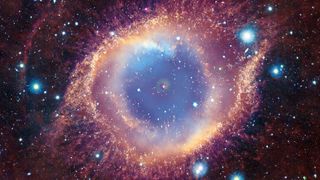
This colorful image of the Helix nebula may mirror what someday could become of our sun and our home planet. Released on March 4, 2025, the composite photo shows a potentially destructive white dwarf at its center. It turns out this star may have destroyed a planet.
Why is this amazing?
This has never been seen before. If this image indeed shows the aftermath of a planet, it could explain a mysterious X-ray signal that astronomers have detected from the nebula for more than four decades.
The Helix nebula as it exists today is the late stage of a star that has ejected its outer layers of gas and left behind a smaller, dimmer ember of a star known as a white dwarf. Telescopes detected highly energetic X-rays coming from this star, named WD 2226-210. But white dwarfs do not typically give off strong X-rays.
"We think this X-ray signal could be from planetary debris pulled onto the white dwarf, as the death knell from a planet that was destroyed by the white dwarf in the Helix nebula," said Sandino Estrada-Dorado of the National Autonomous University of Mexico, the lead author of a new study about the nebula. "We might have finally found the cause of a mystery that's lasted over 40 years."
What happened to the planet?
Astronomers earlier determined that a Neptune-sized planet is in a very close orbit around the white dwarf. Estrada-Dorado and his team of researchers found that there could have been a Jupiter-like planet even closer to the star.
This planet could have, at first, been farther away from the white dwarf, but then was pulled inwards by the gravity of other planets in the system. Once it came close enough, the gravity of the star would have partially or completely torn the planet apart.
"The mysterious signal we've been seeing could be caused by the debris from the shattered planet falling onto the white dwarf's surface, and being heated to glow in X-rays," said Martin Guerrero of The Institute of Astrophysics of Andalusia in Spain, co-author of the study. "If confirmed, this would be the first case of a planet seen to be destroyed by the central star in a planetary nebula."
How does this relate to our sun?
In about 5 billion years, our sun will run out of fuel and expand, possibly engulfing Earth.
"It's important to find more of these [white dwarf planetary] systems because they can teach us about the survival or destruction of planets around stars like the sun as they enter old age," said co-author Jesús Toala of the National Autonomous University of Mexico.
Where can I learn more?
A paper describing these results appeared in The Monthly Notices of the Royal Astronomical Society. You also watch a video about the white dwarf at the center of the Helix nebula and read more about the study's findings.

.jpg) 21 hours ago
1
21 hours ago
1
 English (US)
English (US)